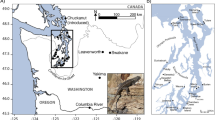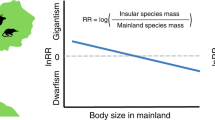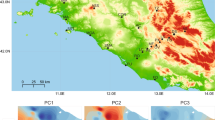Abstract
Hurricanes are catastrophically destructive. Beyond their toll on human life and livelihoods, hurricanes have tremendous and often long-lasting effects on ecological systems1,2. Despite many examples of mass mortality events following hurricanes3,4,5, hurricane-induced natural selection has not previously been demonstrated. Immediately after we finished a survey of Anolis scriptus—a common, small-bodied lizard found throughout the Turks and Caicos archipelago—our study populations were battered by Hurricanes Irma and Maria. Shortly thereafter, we revisited the populations to determine whether morphological traits related to clinging capacity had shifted in the intervening six weeks and found that populations of surviving lizards differed in body size, relative limb length and toepad size from those present before the storm. Our serendipitous study, which to our knowledge is the first to use an immediately before and after comparison6 to investigate selection caused by hurricanes, demonstrates that hurricanes can induce phenotypic change in a population and strongly implicates natural selection as the cause. In the decades ahead, as extreme climate events are predicted to become more intense and prevalent7,8, our understanding of evolutionary dynamics needs to incorporate the effects of these potentially severe selective episodes9,10,11.
This is a preview of subscription content, access via your institution
Access options
Access Nature and 54 other Nature Portfolio journals
Get Nature+, our best-value online-access subscription
$29.99 / 30 days
cancel any time
Subscribe to this journal
Receive 51 print issues and online access
$199.00 per year
only $3.90 per issue
Buy this article
- Purchase on Springer Link
- Instant access to full article PDF
Prices may be subject to local taxes which are calculated during checkout


Similar content being viewed by others
References
Walker, L. R., Lodge, D. J., Brokaw, N. V. L. & Walde, R. B. An introduction to hurricanes in the Caribbean. Biotropica 23, 313–316 (1991).
Scalley, T. H., Scatena, F. N., Lugo, A. E., Moya, S. & Estrada Rulz, C. R. Changes in structure, composition, and nutrients during 15 years of hurricane-induced succession in a subtropical wet forest in Puerto Rico. Biotropica 42, 455–463 (2010).
Pavelka, M. S. M., McGoogan, K. & Steffens, T. S. Population size and characteristics of Alouatta pigra before and after a major hurricane. Int. J. Primatol. 28, 919–929 (2007).
Willig, M. R. & Camilo, G. R. The effect of Hurricane Hugo on six invertebrate species in the Luquillo experimental forest of Puerto Rico. Biotropica 23, 455–461 (1991).
Wiley, J. W. & Wunderle, J. M. The effects of hurricanes on birds, with special reference to Caribbean islands. Bird Conserv. Int. 3, 319–349 (1993).
Endler, J. A. Natural Selection in the Wild (Princeton Univ. Press, Princeton, 1986).
Hegerl, G. C., Hanlon, H. & Beierkuhnlein, C. Climate science: elusive extremes. Nat. Geosci. 4, 142–143 (2011).
Ummenhofer, C. C. & Meehl, G. A. Extreme weather and climate events with ecological relevance: a review. Phil. Trans. R. Soc. B 372, 20160135 (2017).
Grant, P. R. Evolution, climate change, and extreme events. Science 357, 451–452 (2017).
van de Pol, M., Jenouvrier, S., Cornelissen, J. H. C. & Visser, M. E. Behavioral, ecological and evolutionary responses to extreme climactic events: challenges and directions. Phil. Trans. R. Soc. B 372, 20160134 (2017).
Grant, P. R. et al. Evolution caused by extreme events. Phil. Trans. R. Soc. B 372, 20160146 (2017).
Johnson, A. B. & Winker, K. Short-term hurricane impacts on a neotropical community of marked birds and implications for early-stage community resilience. PLoS ONE 5, e15109 (2010).
Lodge, D. J. & McDowell, W. H. Summary of ecosystem-level effects of Caribbean hurricanes. Biotropica 23, 373–378 (1991).
Batista, W. B. & Platt, W. J. Tree population responses to hurricane disturbance: syndromes in a south-eastern USA old-growth forest. J. Ecol. 91, 197–212 (2003).
Wulff, J. L. Effects of a hurricane on survival and orientation of large erect coral reef sponges. Coral Reefs 14, 55–61 (1995).
Spiller, D. A., Losos, J. B. & Schoener, T. W. Impact of a catastrophic hurricane on island populations. Science 281, 695–697 (1998).
Crandell, K. E., Herrel, A., Sasa, M., Losos, J. B. & Autumn, K. Stick or grip? Co-evolution of adhesive toepads and claws in Anolis lizards. Zoology 117, 363–369 (2014).
Kolbe, J. Effects of hind-limb length and perch diameter on clinging performance in Anolis lizards from the British Virgin Islands. J. Herp. 49, 284–290 (2015).
Losos, J. Lizards in an Evolutionary Tree: Ecology and Adaptive Radiation of Anoles (Univ. of California Press, Berkeley, 2009).
Kingsolver, J. G. et al. The strength of phenotypic selection in natural populations. Am. Nat. 157, 245–261 (2001).
Kingsolver, J. G. & Diamond, S. E. Phenotypic selection in natural populations: what limits directional selection? Am. Nat. 177, 346–357 (2011).
Siepielski, A. M., DiBattista, J. D. & Carlson, S. M. It’s about time: the temporal dynamics of phenotypic selection in the wild. Ecol. Lett. 12, 1261–1276 (2009).
Grant, P. R. & Grant, B. R. Evolution of character displacement in Darwin’s finches. Science 313, 224–226 (2006).
Forsman, A. Rethinking phenotypic plasticity and its consequences for individuals, populations and species. Heredity 115, 276–284 (2015).
Losos, J. B. et al. Evolutionary implications of phenotypic plasticity in the hindlimb of the lizard Anolis sagrei. Evolution 54, 301–305 (2000).
Kolbe, J. J. & Losos, J. B. Hind-limb length plasticity in Anolis carolinensis. J. Herp. 39, 674–678 (2005).
Wikelski, M. & Thom, C. Marine iguanas shrink to survive El Niño. Nature 403, 37–38 (2000).
Stuart, Y. E. et al. Rapid evolution of a native species following invasion by a congener. Science 346, 463–466 (2014).
Lázaro, J., Dechmann, D. K. N., LaPoint, S., Wikelski, M. & Hertel, M. Profound reversible seasonal changes of individual skull size in a mammal. Curr. Biol. 27, R1106–R1107 (2017).
Schoener, T. W., Kolbe, J. J., Leal, M., Losos, J. B. & Spiller, D. A. A multigenerational field experiment on eco-evolutionary dynamics of the influential lizard Anolis sagrei: a mid-term report. Copeia 105, 543–549 (2017).
Macrini, T. E., Irschick, D. J. & Losos, J. B. Ecomorphological differences in toepad characteristics between mainland and island anoles. J. Herp. 37, 52–58 (2003).
Laska, A. L. The structural niche of Anolis scriptus on Inagua. Breviora 349, 1–6 (1970).
Kamath, A. & Losos, J. B. Does ecological specialization transcend scale? Habitat partitioning among individuals and species of Anolis lizards. Evolution 71, 541–549 (2017).
Spendelow, P. Niche Width and Morphological Variation (Anole). PhD thesis, Univ. of Washington (1985).
Irschick, D. J., Vanhooydonck, B., Herrel, A. & Meyers, J. Intraspecific correlations among morphology, performance and habitat use within a green anole lizard (Anolis carolinensis) population. Biol. J. Linn. Soc. 85, 211–221 (2005).
R Core Team. R: A Language and Environment for Statistical Computing http://www.R-project.org/ (R Foundation for Statistical Computing, Vienna, 2017).
Lande, R. & Arnold, S. J. The measurement of selection on correlated characters. Evolution 37, 1210–1226 (1983).
Acknowledgements
This work was made possible thanks to the Pine Cay Homeowners Association and the US National Science Foundation. All procedures were approved by the Turks and Caicos DECR (Initial Permit: 17-08-02-14; Revisit Permit: 17-10-01-15) and Harvard University IACUC (26-11). We thank C. Santoro for help in the field and with the manuscript, and members of the Losos laboratory for valuable feedback. A.H. thanks the Caribaea Initiative for promoting science in the Caribbean and facilitating the networking that made the initial Turks and Caicos study possible.
Reviewer information
Nature thanks E. Palkovacs and the other anonymous reviewer(s) for their contribution to the peer review of this work.
Author information
Authors and Affiliations
Contributions
C.M.D., A.H., J.J.K. and J.B.L. conceived the study; C.M.D., A.H. and A.-C.F. conducted fieldwork; C.M.D., A.J.G., A.-C.F. and A.K. conducted analyses; C.M.D. and J.B.L. wrote the initial draft of the manuscript; and T.W.S., J.J.K., A.H., A.-C.F., A.J.G. and A.K. all contributed to interpretation of the data and to editing of subsequent drafts of the manuscript.
Corresponding author
Additional information
Competing interests: The authors declare no competing interests.
Publisher’s note: Springer Nature remains neutral with regard to jurisdictional claims in published maps and institutional affiliations.
Supplementary information
Supplementary Information
This file contains: (1) Description of lizard behaviour on a perch in hurricane-force winds; (2) Additional analysis details and results; and (3) Variance estimates.
Rights and permissions
About this article
Cite this article
Donihue, C.M., Herrel, A., Fabre, AC. et al. Hurricane-induced selection on the morphology of an island lizard. Nature 560, 88–91 (2018). https://doi.org/10.1038/s41586-018-0352-3
Received:
Accepted:
Published:
Issue Date:
DOI: https://doi.org/10.1038/s41586-018-0352-3
This article is cited by
-
Trait-based sensitivity of large mammals to a catastrophic tropical cyclone
Nature (2023)
-
Island Tiger Snakes (Notechis scutatus) Gain a ‘Head Start’ in Life: How Both Phenotypic Plasticity and Evolution Underlie Skull Shape Differences
Evolutionary Biology (2023)
-
Population density of the tropical lizard Anolis cristatellus in urban and forested habitats after a major hurricane
Tropical Ecology (2023)
-
Effects of incubation temperature on development, morphology, and thermal physiology of the emerging Neotropical lizard model organism Tropidurus torquatus
Scientific Reports (2022)
-
Coupling phenotypic changes to extinction and survival in an endemic prey community threatened by an invasive snake
Scientific Reports (2022)
Comments
By submitting a comment you agree to abide by our Terms and Community Guidelines. If you find something abusive or that does not comply with our terms or guidelines please flag it as inappropriate.



